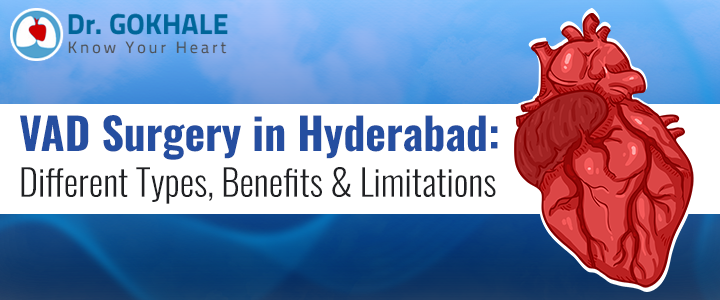Ventricular Assist Device Surgery, also called VAD Surgery, is nothing short of a lifeline for patients whose hearts fail to pump blood effectively.
“It is a remarkable medical procedure that assists in improving blood circulation, prevents further deterioration, aids in heart transplant surgery, and is the most viable long-term option that drastically improves the quality of life of heart patients,” says Dr. Alla Gokhale Krishna Gokhale, the best heart surgeon in Hyderabad and a leading specialist in VAD Surgery for heart patients.
While it is an excellent treatment option, the procedure has limitations too. There are different VAD surgeries, each with benefits, regulations, and suitability cases. With inputs from the best heart surgeon in Hyderabad, Dr. Alla Gopala Krishna Gokhale, we will briefly delve into VAD Surgery, its types, and its benefits for heart patients.
What is VAD Surgery?
Every heart condition ultimately weakens the heart’s muscle, which impedes its ability to pump blood. Shortness of breath, fatigue, weakness, organ dysfunction, and every common heart problem find their sources in the blood circulation problem resulting from a weaker blood pump.
Ventricular Device Surgery treats this problem by implanting a ventricular device that improves blood circulation. Different types of ventricular device surgeries are performed based on the health of the patient and the type and severity of heart problems:
Left Ventricular Assist Device (LVAD Surgery):
LVAD surgery is the most common VAD surgery performed to improve blood circulation. The ventricular device in LVAD surgery is implanted in the heart’s left chamber near the left ventricle and aorta, which is responsible for pumping oxygenated blood to the rest of the body. This procedure is performed in patients with weakness in the left side of the heart.
Right Ventricular Assist Device (RVAD Surgery):
The ventricular assist device is used in RVAD surgery to assist the right ventricle in pumping blood to the lungs for oxygen. This is performed in patients with weakness in the right side of the heart, which is less common than LVAD surgery.
Biventricular Assist Device (BiVAD):
As the name suggests, the ventricular device is placed at both the ventricles – left and right – to pump the blood to the lungs for oxygen and then to pump the oxygenated blood to the rest of the body. This procedure is performed when both sides of the heart are weakened and impaired, which happens in severe cases of heart failure.
Ventricular Assist Device Surgery in Hyderabad: A Life Line for Heart Patients
A ventricular device remarkably improves blood circulation problems in heart patients by powering the heart to pump blood adequately. As a treatment option, it can be a temporary respite until the primary treatment option or can be a long-term solution that helps with blood circulation.
“A VAD surgery drastically improves the heart function; it can serve as a precursor and bridge for patients undergoing heart transplantation, aid in recovery after heart surgery, and improve heart function to the point that heart surgery may be needed. It is truly a remarkable procedure,” says the top heart transplant surgeon in Hyderabad, Dr. Alla Gopala Krishna Gokhale.
That said, VAD surgery also comes with its limitations. Given the surgical hardware and power sources involved in the assist devices, they may inadvertently limit patients’ mobility and increase dependency. The cost restrictions and other possible complications also need to be factored in. If you want more information on VAD surgery or LVAD Surgery in Hyderabad, we recommend you consult the leading VAD Surgery Specialist, Dr. Alla Gopala Krishna Gokhale.
As a leading heart transplant surgeon, Dr. Alla Gokhale performed the first left ventricular assist device (LVAD) surgery in Andhra Pradesh in 2004. Ever since, he has performed hundreds of ventricular assist device surgeries that have given a new lease of life to patients with heart conditions.














